Vertical farming is the future of innovative agriculture globally. In fact, vertical farming may play a role in meeting the ever-growing need for food. Due to this increased demand for vertical farming, your vertical grow room design and setup are continually becoming more important.
Indoor cannabis growers can all agree on one thing: electricity is expensive! Some places in the country like Humboldt County are known for their sun-grown flower. But growers in other locations don’t have the luxury of growing outdoors. Whether it’s due to climate or local regulations, many growers in the regulated cannabis market are forced to grow indoors.
Vertical farming increases your total canopy area and increases your total yield while decreasing the average cost per pound.
Every grow operation is unique and requires a customized installation and vertical grow room design. What works for one cannabis cultivator may not necessarily work the same way for the next. Location, building structure, size, locality, local laws, local climate weather patterns, OSHA compliance, and SEISMIC compliance, are just a few factors to consider.
Types of Vertical Setups
Vertical farms and a vertical grow system can be set up in all kinds of facilities, ranging from warehouses, large buildings, storage containers and mobile grow boxes. But all of them really fall under two basic categories: true vertical and stacked vertical.
True Vertical
In true vertical farming, you’ll see the plants growing out of the side of a column, with all the nutrients and water dripping top down. Organic kale, lettuce, and other greens are commonly grown in true vertical farms. There are many different variations of this method, but all of them have the same goal in mind.
Stacked Vertical
Stacking grow trays above each other is known as stacked vertical farming. Because space is a concern both vertically and horizontally, you’ll want to keep the plants topped and defoliated, so that they remain short and stubby. Some strains and cultivars are better fitted for indoor grow operations than others.
Vertical grows should be wise in selecting which genetics to deploy. The best-yielding vertical farms grow phenos that are naturally short with big, heavy buds. They also tend to have fewer leaves, requiring less hands-on defoliation. However, some experienced growers do grow taller strains as well. Technically, you could grow just about any strain of cannabis or hemp in a vertical farm setup.
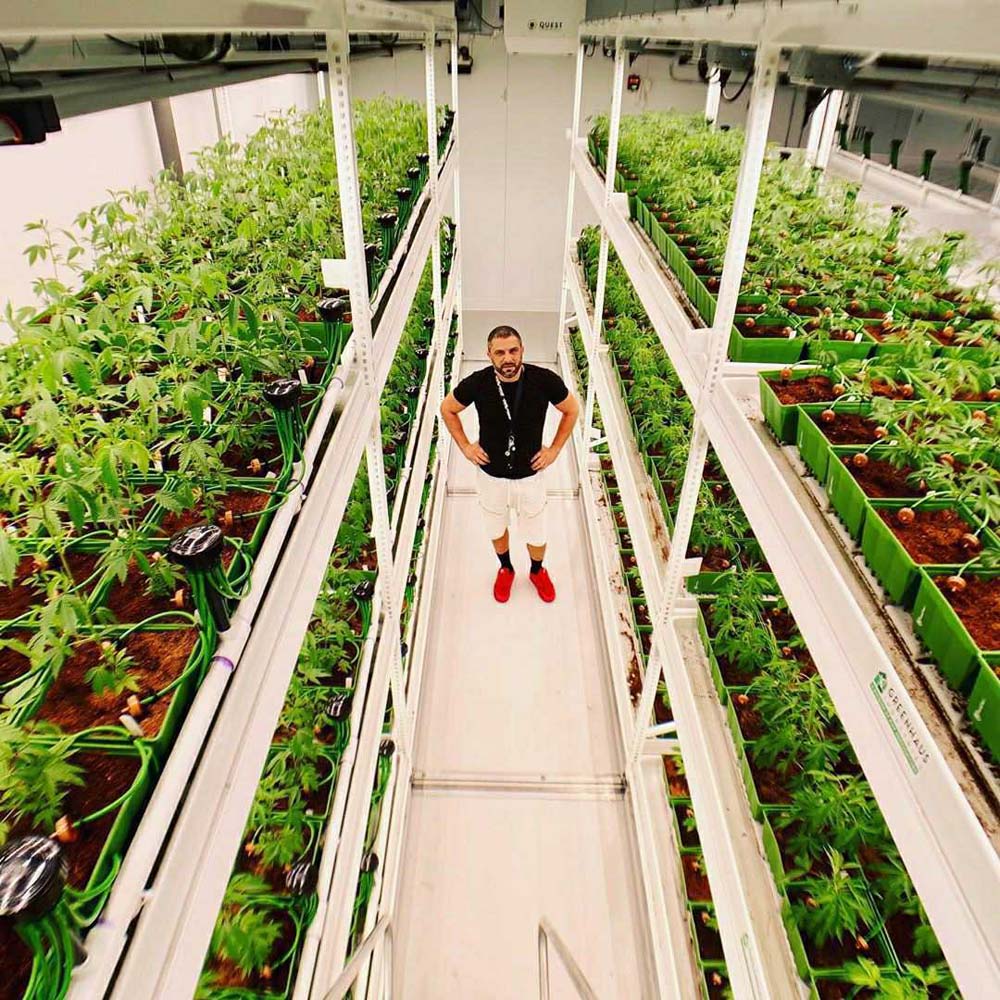
Benefits Of Vertical Growing
So why is vertical farming such a big deal in the cannabis cultivation world? It’s because it allows growers to experience:
- Reduced air conditioning costs
- Reduced heating costs
- Decreased energy consumption
- Doubled or tripled yields
- Reduced water usage
- Reduced fertilizer usage
- Decreased cycle time
- Decrease in overall cost per pound
Vertical Farming In Every Stage Of Your Grow
Vertical farming has profound applications in four major areas.
Nursery
You’ll want to consider the flow of your space in the early stages of your design phase. Begin by itemizing all of the fixtures, including HVAC, drains, sprinklers, electric panels, doors, overhead emergency lights, and pipes.
If you’re designing a new space or upgrading one to vertical racking, it’s a good idea to keep an open design on a final location like a wall or door. The goal is to maximize your canopy, given all the obstacles and objects in the room.
You may not always need door relocation. However, adjusting the location of the door may prove to be beneficial not just for maximizing canopy yield, but also for improved safety and workplace ergonomics.
Cultivation
In order to efficiently design your cultivation layout, you’ll need to consider things like:
- Type of grow space
- Desired number of grow tiers
- Types of trays
- Height between racks
- Critical wall dimensions
- Doors, egress paths, columns
- Electrical panels
- Ceiling height
- Light height
- Type of flooring
- Any other obstructions
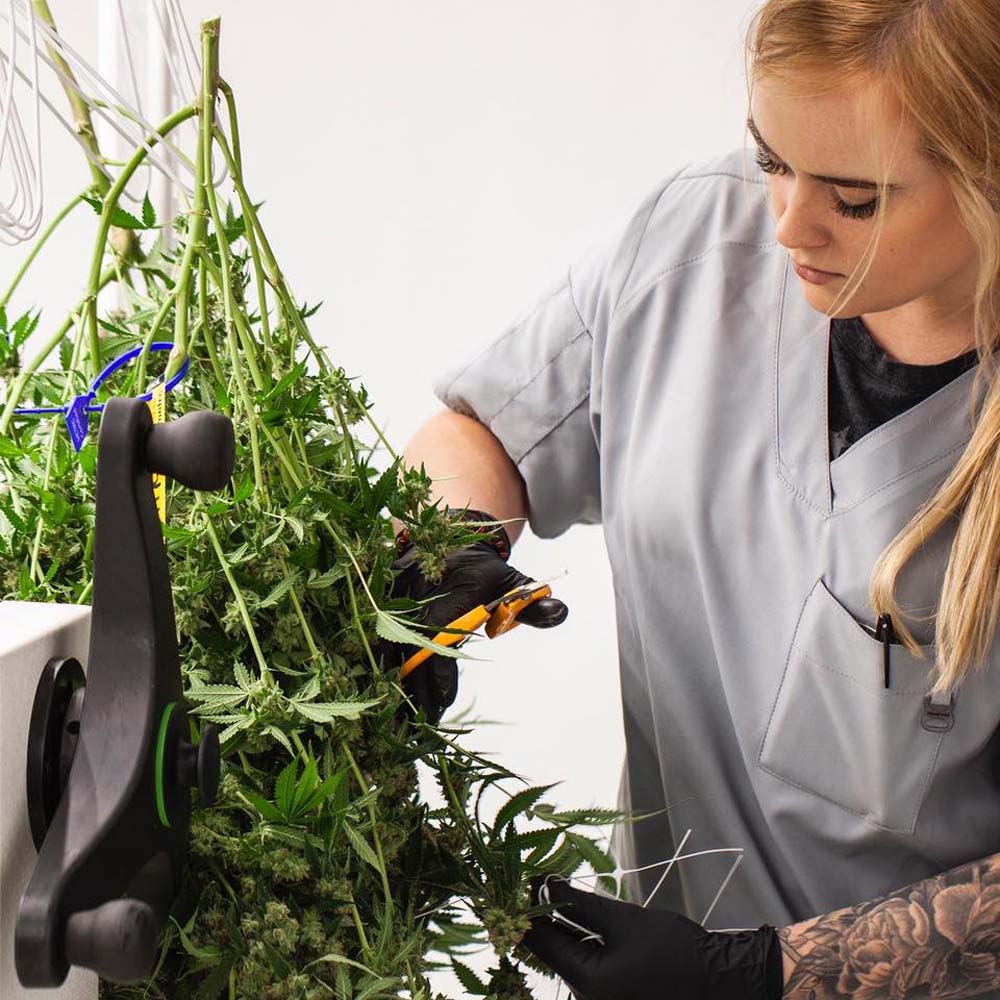
Drying & Curing
Top growers know that the drying and curing stage is crucial to delivering top-notch products that have realized their full genetic potential.
Drying carts are a crucial part of your process and can really help streamline your workflow. They are specially designed for hanging your plants to dry and come with special finger attachments.
Storage
Shelf carts are great for both storing and transporting your product. The levels are completely adjustable and you can easily add more shelves as needed.
Combo carts bring the best of both worlds by providing exclusive hanging attachments for drying and adjustable shelves below for storage and transport. Now that we’ve covered the different types of vertical farm setups, the benefits, applications, and storage, let’s move on to servicing the upper levels.
How Do You Service the Upper Levels?
This is one of the most common questions we get. It’s important to have full access to the upper levels so that all the plants in your facility get the exact same scrutinous eye and nurturing hands. You don’t want pests, mold, or anything else to creep up on you if the top level of your vertical system can’t be seen or accessed.
The NEW Elevate™ Platform System is a robust, lightweight, and portable deck to allow cultivators to access PIPP’s Multi-Tier Mobile Grow Racks quickly, efficiently, and most importantly – safely.
Pipp’s latest innovation, the Elevate™ Platform System, features the following:
- Quick and simple setup with more time available to care for plants and less time spent preparing your workspace.
- Lightweight components allow one person to set up the entire system. Two people make it a breeze.
- Aluminum and Galvanized steel components for great corrosion resistance.
Safety is a big concern for any commercial operator. Ensuring workers have easy access to the plants while also minimizing their reach and risk of fall is crucial for owners and managers running a tight ship.
Cost is another factor for commercial grow looking to optimize their facility and introduce vertical racks. How to service those upper levels becomes a decision between cost, efficiency, and scale. The simplest option will be the cheapest, yet it will require more labor hours to move between the rows and levels. The higher-cost option is the most automated, yet the most expensive.
We’ve covered how to access the upper levels, so now let’s move on to the tools used to do this. There are three major types: ladders, rolling scaffolding, and lifts.
Ladders
Ladders, while simple, is a bit more challenging to use in vertical farming.
Because they do not provide a flat working space, they can make things less ergonomic.
The taller the ladder, the wider it has to be to allow for ease of movement. Platform ladders are good for when workers need to spend long periods of time in one particular spot on the ladder.
Platform ladders come with a rail guard, located at the top. This helps stabilize the user while accessing the upper levels. It also allows the user to free up both hands, in order to focus on the work. Some of the platform ladders even come with castors that make it easier to move from one area to the next.
Most store-bought ladders will be OSHA-compliant too.
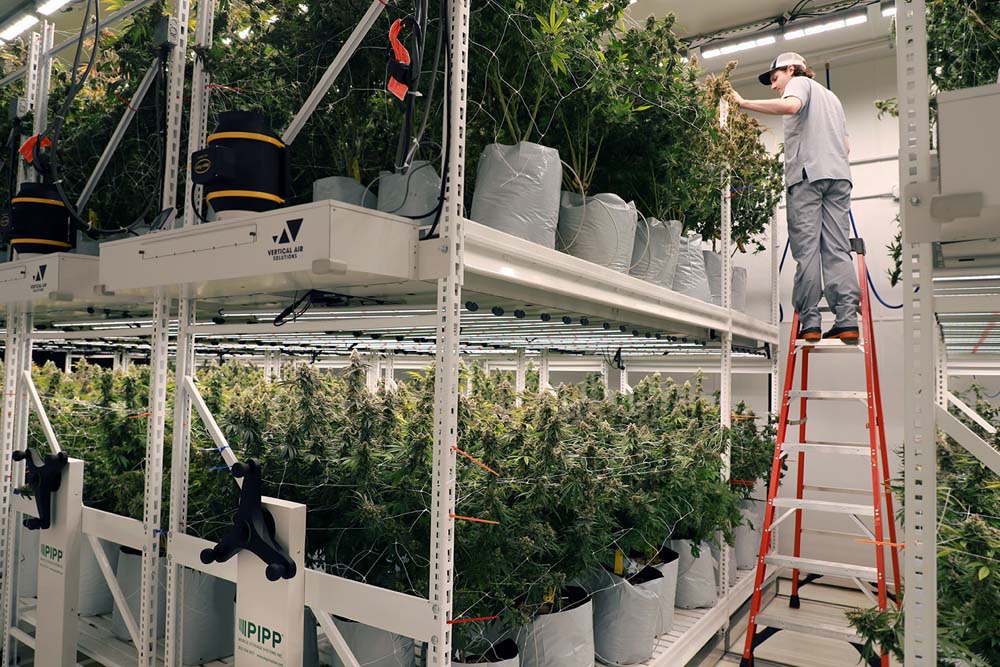
Rolling Scaffolding
While ladders are the least expensive option, rolling scaffolding or platforms are a bit more costly. The advantage of using scaffolding is that you can easily move from room to room. Workers who have to change their position on a frequent basis would benefit from rolling scaffolding.

Lifts
Lifts are another option, however, they are usually the most expensive solution for accessing and working at those higher levels. However, if your grow is larger in scale and demands that workers spend long periods of time at the upper levels, then lifts may be a better option.
Lifts can be manually operated or motorized. Pricing varies greatly, depending on your selected options. If you have two tiers or more, lifts can offer the greatest amount of efficiency for your space and workforce.
For a three and four-level grow operation, lifts are typically necessary. Lifts can be moved while a person is still on the equipment. Instead of climbing down to move the equipment and climb back up, lifts save a ton of time. They are also usually better powered but will need recharging after use.
While there are several different choices available, you’ll probably want to contact a PIPP design/installation professional in order to help you determine which option is right for you. This can assist you in making an informed decision that best fits your facility’s needs.
This can assist you in making an informed decision that best fits your facility’s needs.
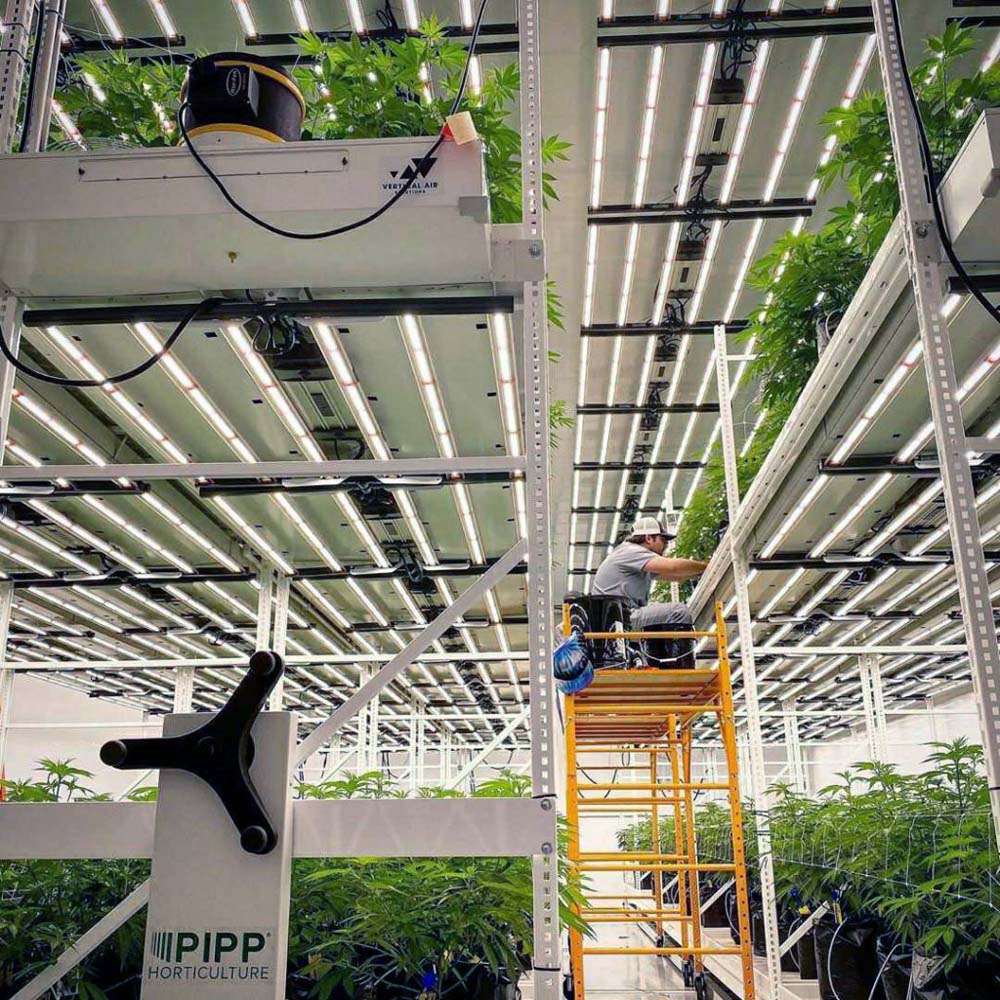
Some Tips To Keep In Mind
Figuring out how to design and oversee vertical grow can be a bit overwhelming. However, you don’t have to go at it alone. No matter what route you choose, there are key fundamentals to any vertical farm grow setup.
- When deciding on the best options for your grow facility, you’ll need to weigh the cost of the solution versus the efficiencies the solution offers. But keep in mind, worker efficiency is crucial to the old adage “time is money”.
- Typically, the more efficient a solution, the higher its cost. You may want to consider doing timed studies with employees to get a handle on how much time may be spent inefficiently using one solution over another. This will help you determine the right cost-benefit solution for you.
- Also, you’ll want to be sure that whatever solution you decide fits from an ergonomic standpoint. You don’t want to fatigue your employees or put them in unsafe working conditions. The best solution will allow one to stand comfortably and minimize time spent bending over or working in a stretched position.
- The best solutions include the storage of tools needed to access the upper levels. Your workers should experience a safe and easy transition from one tool to the next in the course of their work.
- Lastly, safety should always be a priority. Because no two grow operations are the same, setups can differ and solutions need to be customized. Bars and safety rails help provide security to workers. And high density grow racks come equipped with a locking mechanism that secures its position while people are working on the equipment.
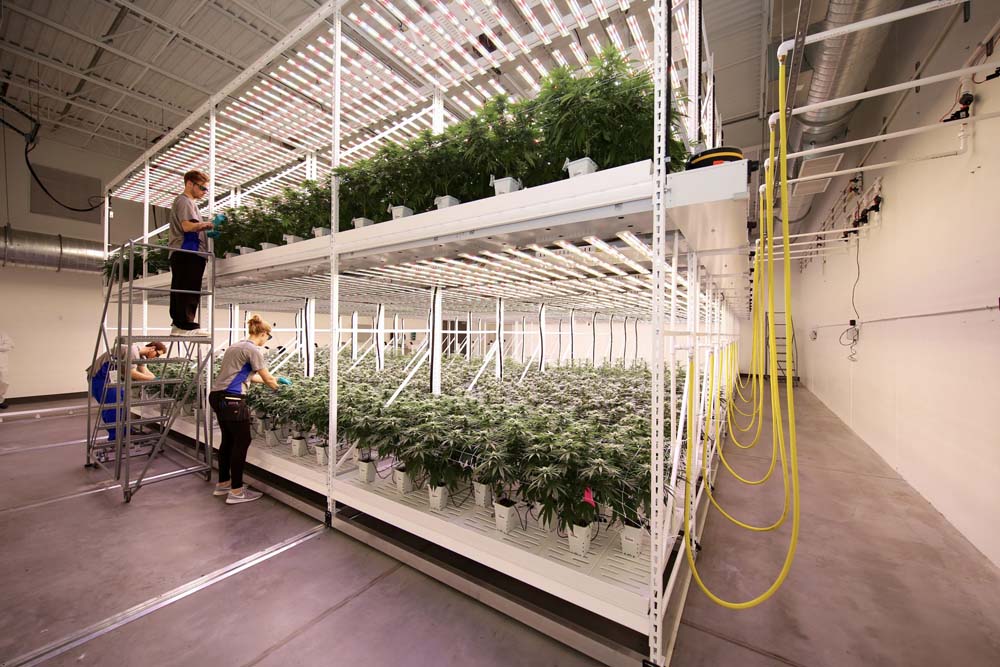
Wrap-Up Conclusion
Vertical farming is the future for indoor cannabis growers. As a cultivation
business scales and increases its square footage or room numbers, facility design can become more complex.
Growing indoors is an expensive venture, but one that can produce incredible results, both with the quality of cannabis and profits.
While you want to maximize your growth and profits, you also want to minimize hassles and costs.
Interested in seeing how much revenue you could be making with vertical farming? Enter your facility’s current canopy space, production metrics, and sales price to see how much you could be making when you upgrade your indoor farm to PIPP Horticulture’s Cannabis Grow Racks!


Add a Comment